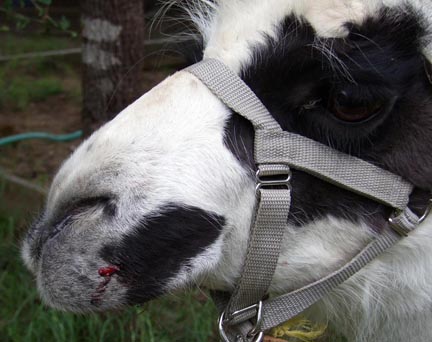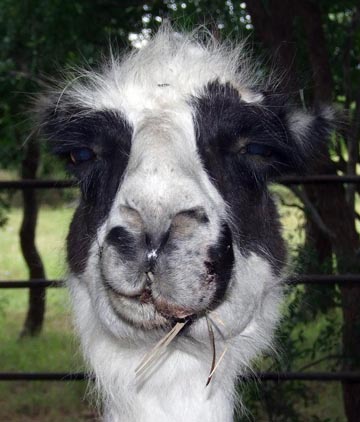
Day 1 puncture

Day 2 swelling lower left lip
|
Day 1 May 21, 2015 While Claud was raking llamas beans about 3:15 pm, Miss Z, a 13 year old, 266 lb mini llama, approached him. He saw blood dripping from a hole in her swollen upper left lip. It was a rattlesnake bite. Claud and Maya, our Great Pyr guard dog, searched the area quickly but found nothing. I was at a fiber group meeting in Elgin, so Claud phoned a member who informed me about the situation. When I got home at 4:30, Claud told me he had called both our llama vet at Sunset Canyon Veterinary Hospital in Dripping Springs (40 mi away) and Elgin Veterinary Hospital (18 mi away). Neither had anyone available who could administer IV rattlesnake antivenin. In desperation I called our small animal vet, Dr. Bonnie Carter at Manor Veterinary Clinic, for advice or referral to another vet. She offered to give the antivenin injection and she was only five miles away! Claud had already hooked up the trailer to the van, so we took Miss Z and a buddy llama to Dr. Carter. Miss Z was a model patient. She stood unmoving while Dr. Carter felt for a large vein in her neck and slowly administered the first half of the first vial, then the second half of the first vial at 5:00 pm. (I had sheared Miss Z a couple of weeks previously so the veins were relatively easy to locate.) Dr. Carter advised waiting 30 – 60 min to assess swelling. If it continued, then a second vial would be needed – and it was. At 6:00 pm she administered it in two halves as before. She recommended against giving antibiotics because they kill the normal gut flora and fauna that llamas must have. We didn’t want any unnecessary complications. We were to watch for infection, and inform her if Miss Z’s behavior changed or symptoms worsened. Day 2 May 22 We saw some swelling of her uninjured right upper lip, the bitten left upper lip was swollen a little more than yesterday, and swelling extended under her chin and along the left side of her mandible. She had a good appetite; eating hay, pellets, carrots, and horse treats with some difficulty in picking them up with her asymmetrical lips. Day 3 May 23 Miss Z’s swelling continued to decrease, her appetite was still good, and she had no other symptoms. Because of an upcoming Memorial Day weekend, I asked Dr. Carter whether we should have antibiotics handy should Miss Z’s lip become infected. She gave us her email address to contact if needed. She asked me to remove the scab from the wound and said it was OK if there was black drainage. I did so, but there was no drainage. Days 4-5 May 24-25 Miss Z’s left upper lip is almost back to normal size and she has no abnormal symptoms. We have not noticed any tissue necrosis, but it may be too early to detect. Summary The antivenin Miss Z was given was manufactured by Ft. Dodge, is in a crystaline form that is difficult to dissolve into solution. Dr. Carter is phasing out her use of Ft. Dodge antivenin and prefers a newer form from Boehringer Ingelheim. http://www.drugs.com/vet/antivenin.html Each Ft. Dodge antivenin vial cost $700. However, compared to our previous experience with a rattlesnake-bitten llama in 2000 when antivenin was not administered (see http://www.scla.us/snakebite/index.html), the price was worth it in terms of reduced llama stress, short recovery time, and our peace of mind. |
Day 1 puncture |
Day 2 swelling lower left lip |
This article was written by Sharon Bramblett, owner of Miss Z. It also appeared in the Summer 2015 issue (p. 17) of the Humming Herald , the SCLA's quarterly newsletter. |